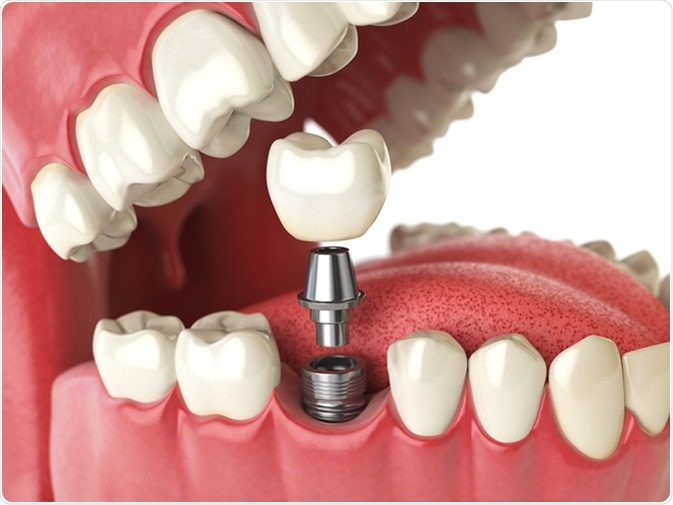The techniques used to place a dental implant are important in determining the chances of success of the procedure. There is usually a planning phase and an implant insertion phase, followed by the fitting of the dental crown or bridge once the implant has healed.
Dental implants are typically made of titanium, which is a biocompatible material. This is accepted by the body so that osseointegration (fusion between the bone and the implant) is more likely to occur. Titanium provides a strong foundation for forming replacement teeth with sturdy support, which continues to strengthen over time. Thus the bond between the bone and the implant continues to grow as they fuse together.

Examination and Planning
It is important for the dental implant surgeon to plan the procedure properly to increase the probability of success. There are several factors that should be considered in the planning process, such as the:
- General health of the patient
- Condition of mucous membranes and jaws
- Shape, size and position of the jawbones
- Shape, size and position of the surrounding teeth (adjacent and opposite)
Additionally, there are some health conditions that can significantly increase the risk for failure and may impact the decision whether to proceed with the surgery. For example, people who have health conditions such as diabetes or osteoporosis, and those who are heavy smokers or have poor oral hygiene, are more likely to be affected by peri-implantitis and failure of the implant. Each of these factors should be evaluated before deciding on the procedure.
An acrylic guide is usually made first to demonstrate the correct positioning and angulation of the implant. In some cases, plaster models are used to determine how many implants will be needed and the ideal positioning of the implants.
X-ray or computed tomography (CT) scans may be used to gain insights about the positioning of the jaw and the density of the bone, which are important factors for the success of dental implantation. The image can then be loaded into a CAD/CAM software program to simulate the desired treatment and result.
Insertion of the Implant
Dental implant surgery involves first making a small incision in the gum that exposes the bone so that a dental drill can be used to shape the site where the abutment screw will be placed into the jawbone. Depending on the specific patient case, the procedure can be performed in one or two stages.
In the one-stage procedure, the implant is placed into the prepared site and then covered with a healing cap that protrudes through the gum. The healing cap can be removed after a period of 3-6 months when osseointegration has occurred. The permanent abutment can be attached at this time. The prosthetic tooth or crown is then fixed in place over the abutment.
Two-stage surgery is preferred when the bone density or quality is lower than ideal, as this type of procedure will increase the likelihood of success. In this procedure, a cover screw is initially placed directly over the top of the implant, and the gum is sewn over the screw while it heals. At this time, a second procedure is required to make an incision in the gum to uncover the implant and attach the healing cap. Following the healing of the gums, the cap can then be removed and the abutment attached. Similar to the one-stage procedure, the prosthetic tooth or crown can then be fixed in place over the abutment.
Fitting of Crowns or Bridges
It usually takes the gums approximately six weeks to heal fully after the implant has been inserted, at which point another impression of the mouth should be taken with an X-ray or CT scan. This helps to create a model of the teeth that is instrumental in the construction of the crown or bridge that will be inserted so that it matches the shape of the jaw and other teeth.
After the crown or bridge to be inserted has been prepared, it is cemented onto the abutment on the dental implants. The appearance, fit and function should then be assessed, including the way the upper and lower jaw fit together when the patient bites down.
The follow-up process typically takes several months as the dental implant heals, with regular appointments to review the progress, stability and function of the implants. Patients should be encouraged to prioritize oral hygiene and dental health to help improve the long-term success of the implant. This includes regular brushing, flushing, rinsing, and dental check-ups.
References
- http://www.efp.org/patients/dental-implants.html
- https://www.ucsfhealth.org/treatments/dental_implants/
- http://www.aaid-implant.org/dental-implant-options/alternative-techniques/
- https://www.ncbi.nlm.nih.gov/pubmed/25835792
Further Reading
- All Dental Implant Content
- Dental Implant Risks
- Medical Uses of Dental Implants
- History of Dental Implants
Last Updated: Feb 26, 2019

Written by
Yolanda Smith
Yolanda graduated with a Bachelor of Pharmacy at the University of South Australia and has experience working in both Australia and Italy. She is passionate about how medicine, diet and lifestyle affect our health and enjoys helping people understand this. In her spare time she loves to explore the world and learn about new cultures and languages.
Source: Read Full Article
